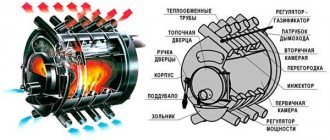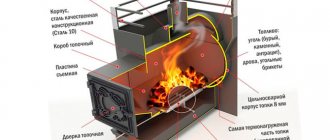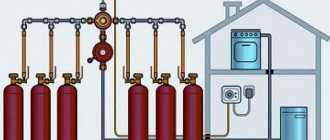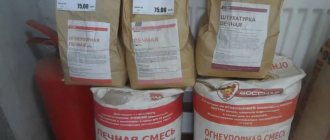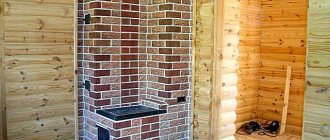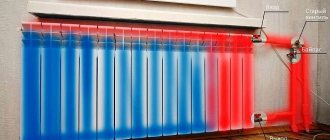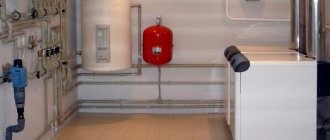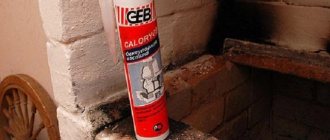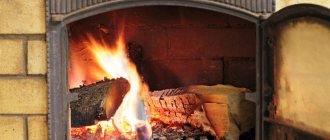Having a dacha or outside the city is the longed-for dream of many residents of modern megacities. Fresh air, tranquility, moderate physical work on the site, the absence of the crazy bustle of the city - what else is needed for a good rest! Therefore, happy owners of dachas try to spend as much time there as possible, often moving completely outside the city for the entire summer season. And at other times, nature is very good, and trips to the dacha on weekends or holidays are practiced throughout the year, and often country estates even become the main “residence” of the owners.
Gas heaters for cottages
But fresh air and a calm, peaceful environment are not the only components of true home comfort. The premises must maintain a comfortable temperature level for residents, and this often becomes a problem. This is especially true when visiting a dacha in spring, autumn or winter, but the summer of 20121 shows that no one is immune from the cold even in such a seemingly favorable period. Not everyone has a real brick oven at their dacha, and you have to tinker with it for a long time to warm up the premises during a short-term visit. Electric heaters are quite “gluttonous” in terms of spending expensive energy. But there is a very good solution that modern heating devices provide - gas heaters for summer cottages.
Let's take a closer look at them - how they are classified, what operating principles are embedded in them, and how to approach choosing the optimal model.
Pros and cons of heating with gas cylinders
Infrared heater powered by bottled gas
A gas stove for heating a house from a bottle operates using propane or butane. The main working component is liquefied during the production process and driven into containers. Converting a gaseous substance into liquid form is necessary, since it will require much larger containers for storage in its normal state. Liquefaction of gas allows it to be stored in cylinders in maximum quantities.
The finished cylinders are connected to a reducer, which reduces the pressure, due to which the gas returns to its original state. Heat is released during the combustion of gas inside the boiler.
The list of advantages of gas heating using cylinders includes:
- complete autonomy of the heating system;
- low consumption of raw materials and minimum fuel costs;
- stable pressure inside the pipes;
- no problems during operation and installation.
This type of stove heating also has its disadvantages. Cylinders cannot be left outside in winter; at low temperatures they release quickly freezing condensate, which prevents a stable flow of gas. In this case, the heating system will not receive enough fuel and will turn off automatically.
It is necessary to connect and store cylinders taking into account safety precautions, since in the event of a leak, gas poses a threat to life and health.
In a private house
The cylinders can be connected to a heating boiler - enough for a small house up to 100 square meters.
m Gas stove is suitable for heating a house up to 100 sq.m. With its help, you can create a convenient and effective heating system for any building. For your home, you should choose standard 50-liter cylinders with liquefied propane, butane or mixtures with flammable substances for summer and winter.
For saunas and baths
A gas sauna stove is capable of heating a steam room to the required level no worse than its standard wood-burning counterpart. It is easy to use, quite safe and does not require large expenses. If we are talking about a small bathhouse or sauna, two or three convectors are installed in it, which run on gas from cylinders. For a large bathhouse with an area of up to 150-200 sq.m. It is advisable to create a separate gas boiler room and install a boiler.
Industrial models
Although a conventional brick wood-burning stove can be converted to use gas, it is better to give preference to ready-made models.
The choice of such units is huge. The devices differ in their features and technical characteristics. Perhaps they have only one undoubted advantage in common: ease of use. There is no desire to convert the chimney for gas equipment? You can always opt for stoves with a coaxial chimney. Such heating devices can be installed even in a city apartment, without worrying about the removal of combustion products. Such models are more expensive, but they are much more efficient and easier to operate.
You can choose a heat-intensive or non-heat-intensive model. For a dacha where the owners come from time to time in winter, a heat-intensive stove would be the best choice. It is capable of accumulating heat, like a regular wood stove. Cooling time depends on the specific model and ranges from 4 to 12 hours. Non-heat-intensive stoves are, in fact, potbelly stoves powered by gas. To maintain heat, it is necessary to ensure its constant combustion.
Thanks to the additional installation of an automation kit, the once primitive stove is transformed into an autonomous heating device. If the draft suddenly disappears, the temperature rises sharply or there are interruptions in the gas supply, the fuses will trip and the furnace will stop working. The main difficulty of such a design solution lies in the labor-intensive process of remaking the chimney.
For the technical possibility of supplying gas, it is necessary to ensure high-quality removal of combustion products in accordance with the requirements of the gas service. Whether it is necessary to start such a complex enterprise at a dacha with seasonal residence is decided by the owner of the house himself. Judging by practical experience, it is more convenient to equip such houses with ready-made models.
Method of connecting gas cylinders to a heating boiler
The gas pressure is reduced using a reducer.
The containers are connected using a special reducer that converts the gas from a standard form to a gaseous one. When connecting a stove or stove, you can use a single gearbox for all containers or a separate gearbox for each. The first option will be less expensive. Several containers are connected to one boiler at once to increase the time between refills; a ramp is used for this purpose.
The wall thickness of gas pipes cannot be less than 2 mm. In areas where they pass through the walls, the pipes are foamed after being placed in separate cases. The boiler is connected to the gas pipeline using a flexible connection. For the gearbox, you can use a sleeve made of rubber fabric or a durite hose.
Gas cylinders must be installed at a distance of at least 2 meters from the boiler in a separate room or in a special gas cabinet with insulation.
Recommendations for masters
When making a stove from a cylinder with your own hands, you need to take into account several nuances. It is necessary to adhere to the basic recommendations and operating rules:
- the chimney should consist of broken sections, since all the heat will quickly escape through a short pipe;
- fuel can be anything - coal, firewood, wood waste, household waste;
- the efficiency increases with increasing chimney length, but straight and downward sections must be avoided;
- heat transfer increases if another container is placed inside the main body, but of a smaller size. This way you can increase draft and prevent smoke from entering the room.
More information about a wood-burning stove made from a gas cylinder:
System components
In order to connect a sauna or home gas stove, you need to choose a boiler with a reduced operating pressure and increased efficiency. If it is necessary to connect the device to a gas pipeline from the main, additionally purchase a gas burner or chimney nozzles for it. The list of main components includes:
- water or standard gas boiler with burner;
- gas containers with a volume of 50 l;
- gearboxes;
- ramp for connecting one or two cylinders;
- shut-off valves;
- gas pipeline complete with pipes and hoses.
Gas consumption using a reducer should not exceed 1.8-2.0 m3/hour. A standard gas reducer with a flow rate of 0.8 cubic meters per hour is not suitable for such a system.
Flaws
Gas ovens are not without their drawbacks. The equipment itself and its installation are by no means cheap. Natural gas, although the most inexpensive fuel, its cost in our country is systematically increasing.
Gas-fired stoves are quite difficult to install and connect. In the event of even the smallest mistake, you can encounter huge problems in using such devices (they either will not do what they are intended for, or will begin to pose a danger to the life and health of residents).
Refilling containers with gas
All cylinders are filled to 85% to prevent an explosion.
A gas stove for a building or bathhouse requires timely filling of containers with fuel. Tanks are not filled to more than 85% of the total volume, since gas can expand and break through the walls of the cylinders if they are filled in the cold and immediately brought into a warm room. Gas supplies can be replenished at gas stations or at independent points. Before selecting and pumping a substance, the container is placed on a scale in order to turn off the gas supply in time and prevent an increase in pressure.
Even if refueling is carried out according to the rules, the risk of overflow remains. Small cylinders of 5 liters fill up to 2 kg, large cylinders of 12 liters up to 6 kg. This amount will be enough to heat a house or bathhouse. The pumping occurs at high speed; if the critical level is exceeded, the excess must be pumped out immediately. It is better to refill cylinders in places where there are electronic scales with a cut-off device, which increases the level of safety.
Choice
If you come to your dacha occasionally in winter and don’t live there permanently, there is no point in installing a heating boiler, installing convectors throughout the house, or building a stove. It is more profitable to buy a gas heater for your dacha that operates in autonomous mode. It quickly heats up the space when needed. The device is selected taking into account the following factors:
- Frequency of application. If you plan to come to a country house 2-3 times a year to celebrate the New Year or Birthday in a narrow circle, a heater with a power of up to 3 kW is suitable, warming up a room of up to 20 m2 to a comfortable temperature of 20 degrees in 2-3 hours. A standard 12-15 liter cylinder will last for a day or two.
- Heating area. For a room no larger than 20 m2, a unit with a power of up to 3 kW is suitable. For a larger area - 5-8 kW.
- Safety. There must be automatic safety devices. During combustion, carbon dioxide will be released. Choose a model equipped with a special control sensor for CO2 content in the air. If the permissible concentration is exceeded, such a device will switch itself off. Sensors for monitoring the burner flame level and overheating of the device itself are also important.
To prevent spontaneous combustion, the device is equipped with an automatic valve system. Control and automation make the operation of the device safer and independent of the constant presence of a person.
Devices with electronics are more expensive, but this is the safety of the family, on which there is no need to skimp.
Attention is paid to appearance and service. The device will be in plain sight, so it is better to choose it according to its design so that it fits harmoniously into the interior
To prevent spontaneous combustion, the device is equipped with an automatic valve system.
Safety precautions
To prevent emergency situations, electric heaters, heating elements, heating coaxial cables and other elements are not used for heating. Fuel cylinders are stored only inside separate cabinets, in the upper parts of which holes are made for ventilation. It is recommended to insulate them from the inside on the sides and bottom using polystyrene foam. Cylinders should be filled according to the rules to avoid a possible explosion of equipment at home. After assembly, the heating unit must be checked for possible leaks.
Making from a barrel
Among other options, you can use a barrel to make a homemade stove. For example, a sauna stove made from a 200-liter barrel would look good; let’s look at the stages of its manufacture:
- The first step is to determine the required height of the barrel using a grinder;
- Next, the inner walls of the barrel are lined with refractory bricks;
- You can limit the combustion chamber using metal sheets or mesh. Remember that the minimum height of the combustion chamber is 60 cm;
- Stones are laid out on a sheet of metal or mesh;
- Next, you should weld a lid to the barrel and install special doors for ease of use.
Features of work in winter
Insulating a cabinet for a gas cylinder
It is better to store floor-mounted or wall-mounted gas containers in insulated cabinets during the winter. At the same time, the cylinders themselves cannot be heated or insulated; they can be located inside separate structures with minimal heating. Empty cylinders cannot be stored; full cylinders may be placed at least 10 meters from the nearest residential premises. Before making calculations, you need to take into account that in winter, energy consumption costs increase greatly, and in summer they decrease.
In the fall, it is recommended to pre-stock fuel and assemble a special rack for storing containers outside the house. The rack is insulated and the cylinders are placed in a horizontal position.
You can rearrange the cylinders vertically only after connecting to a single system. This requirement must be observed, because the gas from the inside presses on the walls and affects the upper part. In a horizontal position, the risk of leakage will be minimized.
Homemade stoves for a summer residence
One of the serious stopping factors, which is why many users do not dare to acquire a convenient gas stove, is the high cost of such equipment. However, if you have certain skills in construction, this problem can be solved by reconstructing a conventional wood-burning stove made of brick. The conversion process itself is not very complicated: you need to put a burner in the firebox and make changes to the design of the chimney. This will allow you to switch to continuous operation to maintain a stable temperature in the house.
Thanks to the additional installation of an automation kit, the once primitive stove is transformed into an autonomous heating device. If the draft suddenly disappears, the temperature rises sharply or there are interruptions in the gas supply, the fuses will trip and the furnace will stop working. The main difficulty of such a design solution lies in the labor-intensive process of remaking the chimney.
For the technical possibility of supplying gas, it is necessary to ensure high-quality removal of combustion products in accordance with the requirements of the gas service.
Whether it is necessary to start such a complex enterprise at a dacha with seasonal residence is decided by the owner of the house himself. Judging by practical experience, it is more convenient to equip such houses with ready-made models. Date: September 25, 2022
What should a chimney look like?
When connecting chimneys to gas equipment, the following recommendations must be observed:
- The chimney can operate no more than two appliances. If two gas units are switched, they must be placed at different levels relative to each other at a distance of 50 cm.
- If both devices are located on the same level, cuts are installed in the chimney.
- The diameter of the smoke exhaust pipe should not be smaller than the cross-section of the connecting pipe.
- If you need to connect several devices, when determining the cross-section, it is assumed that all units will be turned on simultaneously.
- The pipe must be lined to protect it from condensation: it has a destructive effect on the brickwork. This is done by installing a stainless pipe inside.
- Preference should be given to a cylindrical or oval chimney shape. As for square structures, they are not able to create the effective traction necessary for the proper operation of gas equipment.
- The chimney pipe should only be located in a vertical position: there should be no protrusions on it. It is allowed to make a slight slope (up to 30 degrees), subject to strict adherence to the cross-section of the entire structure.
Prohibitions from SNiP:
- Porous materials cannot be used to make a chimney.
- It is prohibited to lay the pipe in residential or non-residential premises with poor ventilation.
Repairing the chimney of a typically wood-burning stove usually requires some serious effort.
Rating of the TOP 10 best gas heaters for summer cottages for 2021-2022
| TOP 3 best gas heaters by price/quality for 2021-2022 | ||
| 1 | Ballu BIGH-55 | Find out the price |
| 2 | Bartolini Pullover I | Find out the price |
| 3 | NeoClima 08HW-BW | Find out the price |
| TOP 3 best gas heaters for garages and cottages | ||
| 1 | Ballu BIGH-3 | Find out the price |
| 2 | Solar gas GII 2.9 | Find out the price |
| 3 | Kovea Power Sense (KH-2006) | Find out the price |
| TOP 2 best outdoor gas heaters | ||
| 1 | Ballu BOGH-15E | Find out the price |
| 2 | NeoClima 09HW-B | Find out the price |
| TOP 2 best portable gas heaters for tents | ||
| 1 | Kovea Fire Ball KH-0710 | Find out the price |
| 2 | Kovea Handy Sun | Find out the price |

